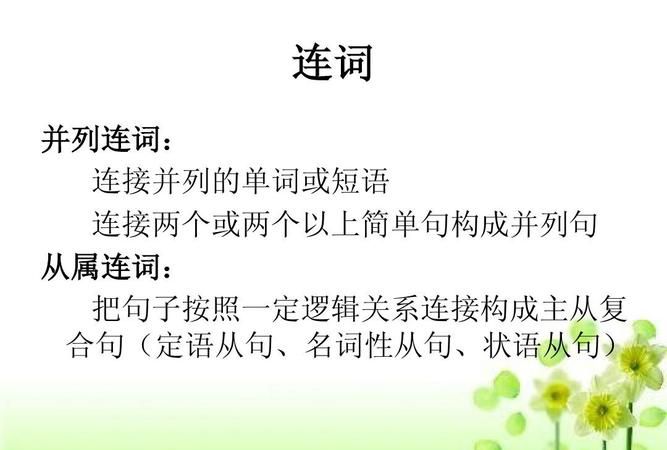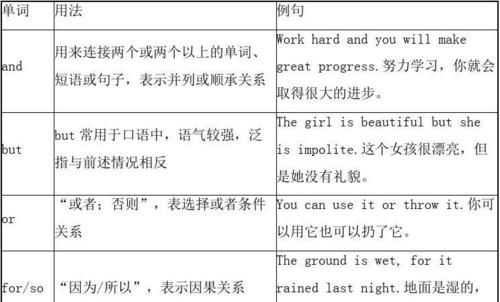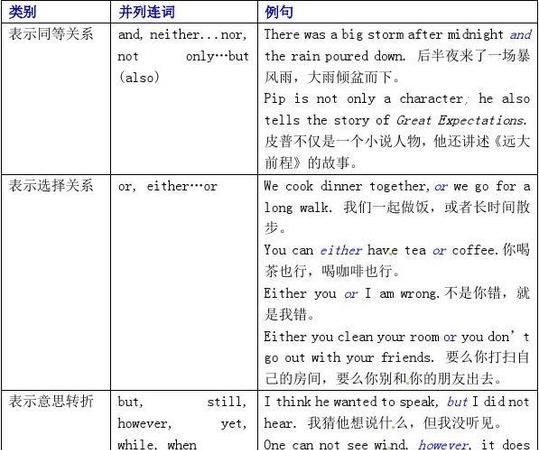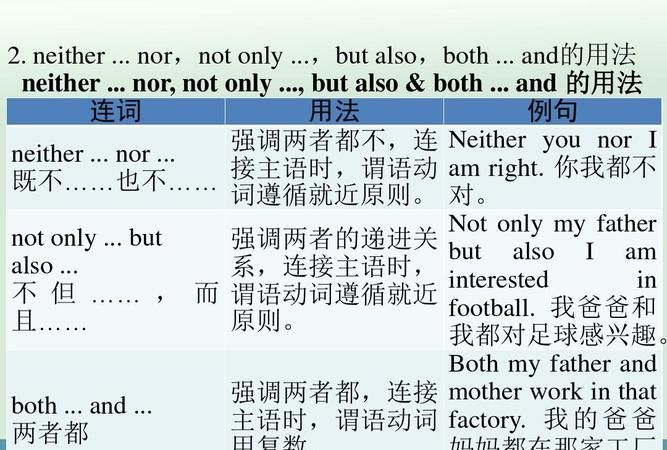本文目录
英语连词的用法总结思维导图
下面我给大家 总结 了英语连词的用法,希望对大家的 英语学习 有帮助。
并列连词与并列结构有:
1、and 与or
2、both …and 两者都
3、not only…but (also), as well as不但…而且)
4、neithe…nor 意思为"既不……也不……"
比较and和or:
1、并列结构中,or通常用于否定句,and用于肯定句。
2、但有时and 也可用于否定句。
表示选择的并列结构
1、or 意思为"否则"。
2、either…or 意思为"或者……或者……"。
表示转折或对比
1、but表示转折,while表示对比。
2、not…but… 意思为"不是……而是……"
表原因关系
1、 for
2、so, therefore
比较so和suchsuch 是形容词,修饰名词或名词词组,so是副词,只能修饰形容词或副 词。so 还可与表示数量的形容词many,few,much, little连用,形成固定搭配。
英语连词用法练习题
1. —Oh, I failed again
—Don’t lose heart. One more effort, ________ you will succeed.
A. so that B. therefore C. however D. and
2. ________ a difficult situation, so you should send him a message and give him some advice.
A. As he is in B. He is in C. Being in D. He being in
3. She said she would work it out herself, ________ ask me for help.
A. and not to B. but not C. and prefer not D. rather than
4. ________ enough time, but I couldn’t do it better.
A. I was given B. Given C. To be given D. Though I was given
5. —How can I wake up so early?
—Set the alarm at 5 o’clock, ________ you’ll make it.
A. but B. or C. and D. so
6. For a person with reading habits, a printed page contains not only words ________ ideas, thoughts and feelings.
A. yet B. and C. or D. but
7. Information technology is taught in most schools, ________ we have entered the information society.
A. so B. while C. still D. for
8. English is understood all over the world ________ Turkey is spoken by only a few people outside Turkey itself.
A. while B. when C. if D. as
9. I was on the point of going to bed ________ Mr. Zhang rang.
A. as B. when C. while D. and
10. I asked him whether he had done all the work himself ________ whether he had had any assistance.
A. and B. but C. nor D. or
11. In some countries, ________ are called “public schools” are not owned by the public.
A. which B. as C. what D. that
12. ________ happens in the world makes us happy and sad by turns.
A. That B. What C. Which D. Whether
13. I read about this story in some book or other, does it matter ________ it was?
A. where B. what C. how D. which
14. One of the men present held the view ________ the book said was right.
A. what that B. what C. that D. that what
15. ________ I had walked for six hours, I was tired out.
A. After B. Before C. When D. As
16. Tom make up his mind to get a seat for the football match ________ it means standing in a queue all night.
A. as if B. as though C. even if D. whatever
17. The roof fell ________ he had time to dash into the house to save his baby.
A. as B. after C. until D. before
18. Doing your homework is a sure way to improve your test scores, and this is especially true ________ it comes to classroom tests.
A. as B. since C. when D. after
19. I have been keeping that photo ________ I can see it every day, as it always reminds me of my college days.
A. which B. where C. whether D. when
20. You may borrow this book ________ you promise to give it back.
A. in case B. so long as C. as if D. even if
【答案解析】
1. D. 考查“祈使句/名词+and+陈述句”句型。句意为:“再努力点,你就会成功的”。
2. B. so(因此)是并列连词,引出一个表示结果的分句,前面应是一个表示原因的分句,而无需再用连词,排除A;C和D又不是 句子 ,也错了。
3. D. 因为rather than是对称连词,意为“而不”
4. A. 因为but是并列连词,后面是个句子,前面也一定是个句子,而不是一个分词 短语 或不定式短语,更不能再用连词though,所以排除B、C和D。
5. C. 考查“祈使句+and+陈述句”句型,意为“如果…就…”。虽然or也可用于此句型,但or是“否则、要不然”之意,如:Work hard, or you’ll fail. (努力学习,否则就会不及格。)
6. D. 因为not only…but (also)…是固定搭配7. D. 因为句中的并列连词for表示原因,是对前面分句所述内容的解释或补充说明。
8. A. 因为句中的并列连词while表示“对比或相反”。
9. B. 因为句中的并列连词when = just at that time, 意为“这时(突然)”。
10. D. 因为只有or才能表示选择,意为“(是…) 还是”。
11. C。本题考查what引导主语从句,并在主语从句中作主语。句意为“在许多国家,所谓的“公立学校”并非公众拥有。
12. B。本题考查引导主语从句的连接词。that引导主语从句只起连接作用,在从句中不作任何成分,无意义,但不能省略。what除引导主语从句外, 还在从句中作成分。which指一定范围内的“哪一个”;whether意为“是否”。根据句意“世上的事喜忧交替”可知答案为B13. D。该题考查宾语从句。可以看作是does it matter which book it was的省略。一定注意此题受母语干扰,很容易错选答案为A。只要抓住题干前一句I read about this story in some book or other的提示,就可知道是指一定范围内的“哪一个”,故答案为D。
14. D。that引导同位语从句;what the book said是同位语从句中的主语。
15. A。本题考查以after引导的时间状语从句,意为“在…之后”。句意为“步行了六小时后,我累坏了”。
16. C。even if=even though,引导的让步状语从句,意为“即使, 尽管”,符合题意。
17. D。本题考查before引导的时间状语从句,意为“在……之前”。句意为“他来不及冲进去救他的孩子,屋顶就塌了”。
18. C。When it comes to. . . 是一固定句型,意为“当谈到……时,涉及”。句意为“做作业是提高考分的一个可靠 方法 ,这在涉及到课堂测验时尤其正确”19. B。该题考查where引导的地点状语从句,表示“在…地方”。句意为“我一直把照片放在我每天都能看到的地方,因为它总使我回想起大学里的日子”。
20. B。so long as=so long as, 意为“只要”,表示条件。句意为“只要你答应归还,你就可以把这书借走”。

英语中常见的连词和用法讲解视频
连词:连接单词与单词、词组与词组、 句子 与句子、从句与主句的词叫连词。
连词也是虚词,不能独立作句子成分。
连词分为并列连词和从属连词两种,并列连词用于连接两个或者两个以上并排列举的单词、词组或者句子,从属连词用于连接从句和主句。
连接单词与单词:
books and pens书和笔
连接词组与词组:
at school or at home在学校或者在家里
连接句子与句子:
You are 12 and she is 10.你12岁,她10岁。
连接从句与主句:
What he said was right.他说的话是正确的。
1.常见并列连词
and, or, but
so, both…and,
not only…but also
either…or, neither…nor
as well as, for
hence, therefore
however, nevertheless等
2.并列连词的用法
大多数时候,并列连词是连接两个事物,少数时候连接三个甚至更多的事物。
连接两个事物:
We are going to invite John and Mary.
我们打算邀请约翰和玛丽。
Do you choose A or B?
你选择A还是B?
We’d better get up early or we’ll be late.
我们早点起床为好,否则会迟到。
It was raining, but they didn’t stop their work.
天在下雨,但他们没停止干活。
He didn’t sweat, nor did he pant.
他没出汗,也没喘气。
连接三个以上的事物:
There were Bob, Paul, Mary and Henry.
有鲍勃、保罗、玛丽和亨利。
You may buy apples, pears, oranges or peaches.
你可买苹果、梨子、橘子或者桃子。
本文作者:丹丹英语(公众号:英语语法学习)
本文为原创 文章 ,版权归作者所有,未经授权不得转载!

英语中常用的连接词有哪些怎么用
英语中的连接词作为语篇衔接的一种手段,对篇章的衔接、连贯起着重要的作用。常用英语连接词有哪些呢?本文是我整理的常用英语连接词,欢迎阅读。
连接词
(1)表选择关系或对等关系的连接词:either…or…,neither…nor, or, as well as…, and, both…and…。
(2)表因果关系或对等关系的连接词:therefore, so, as a result, as the result of …,because of, due to …,owing to, thanks to等。
(3)表时间顺序的连接词:the moment, as soon as, at first, then, later, meanwhyle, at the beginning, in the end, before long, for the first(second…)time, the minute等。
(4)表转折关系的连接词:yet, and yet, but , while, on the contrary, on the other hand, however, at the same time(然而)等。
(5)表解释说明的连接词:that is, that is to say, in other words, such as, for instance, and so on, etc. and the like等。
(6)表递进关系的连接词:not only…but (also), what's more, what's worse, besides, in addition, worse still, moreover, above all等。
(7)表示总结的连接词:in a word, on the whole, in short, briefly, in brief, to sum up, in all等。
注意英语过渡词的用法
1、表示时间的
af first 起初
next 接下来
then 然后
after that 那以后
soon after ……之后不久
finally 最后
in the end 最后
eventually 最终
at last 终于
lately 近来
recently 最近
since then 自从那时起
after that 那以后
in no time 不一会儿
after a while 一会儿
afterward 后来
to begin/start with=in the first place 首先、第一点
immediately 立即、马上
meanwhile=in the meantime=at the same time 在此期间、同时
earlier, until now 直到现在
suddenly=all of a sudden 突然
as a young man 当…… 是个年轻人的时候
at the age of… 在……岁的时候
as early as 早……的时候
as soon as 一……就……
before, the other day 几天前
early in the morning 大清早
after/before dark 天黑后/前
one day 有一天
one afternoon 一天下午
one morning 一天早晨
2、表示空间的
to the right/left 朝右/左
on the rinht/left 在右/左边
in the middle of 在中间
in front of 在前面
in the front of 在前面
at the back of 在后面
at the bottom of 在底部
on the edge of 在……的边上
on top of 在……的顶部
opposite to 与……相对
close to 靠近
near to 在……附近
next to 与……相邻
under 垂直在下
over 垂直在上
below 在下方
above 在上方
across 在……的另一边
around 在周围
behind 在后
before 在前
against 靠着、抵着
further on 再往前
3、表示列举和时序
first, second, third…finally
firstly, secondly, thirdly…finally
first of all, next then, lastly
for one thing…for another…
at the same time
at first
at last
4、表示列举
for example 例如:……
namely 即……
for instance 例如:……
that is (to say) 也就是说
such as 如……
take…for example 拿……来说
li
ke 像……
5、表示比较或对比
similarly 同样地
in the same way 以相同的方式
compared to 与……相比
while 而
still=nevertheless 然而
on the contrary 正相反
different from 与……不同
on (the) one hand…on the other hand 一方面……另一方面
in contrast with 与……成对比
6、表示增补
and 而且
both…and 不但……而且
not only…but also 不但……而且
as well as 不但……而且
also=besides=furthermore=more over 此外、而且
in addition 并且
apart from 除了……之外
what's more 而且、更重要的
for another 另一方面
worse still=what's worse=to make matter worse 更糟糕的是 including 包括
7、表示因果
because 因为
since 既然
now that 既然
therefore 因此
as a result (of) 结果
because of=on account of 因为
thanks to 多亏、由于
for this reason 由于这个原因
if so 如果这样
if not 如果不是这样
8、表示目的
for this purpose
in order to do
so as to do
so that…
in order that…
9、表示让步
though/although
in spite of
whatever/however/whoever=no matter+疑问词
even if/ even though
10、表示递进或强调
besides 况且
what's more 更重要地是
thus 这样
above all 首先
in fact/ as a matter of fact 事实上
in other words 换句话说
in that case 那样的话
particularly 特别地
11、表示转折
however 然而
while 而
12、表示总结
in a/one word 简言之、一句话、总之
generally speaking 一般说来
in short=in a few words 简言之
in cOnclusion=lastly 最后地
on the whole=taking everything into consideration 从总体来看、大体上 therefore 因此
as has been mentioned 正如所提到的
it is quite clear that 很显然
there is no doubt that 毫无疑问
it is well-known that 大家都知道
as we all know=as is known
to us all 大家都知道
as/so far as I know 据我所知
to sum up=to summarize=in summary 总之
13、表示转折话题
by the way 顺便说
in my opinion 依我看来
to tell the truth 说实话

英语连接词都有哪些
一、概说
连词是一种虚词,用于连接单词、短语、从句或句子,在句子中不单独用作句子成分。连词按其性质可分为并列连词和从属连词。并列连词用于连接并列的单词、短语、从句或句子,如and, but, or, for等;从属连词主要引出名词性从句(主语从句、宾语从句、表语从句等)和状语从句(时间状语从句、条件状语从句、目的状语从句等),引出名词性从句的连词如that, whether等,引出状语从句的连词如when, because, since, if 等。
二、并列连词的用法
1. 表示转折关系的并列连词。这类连词主要有 but, yet 等。如:
Someone borrowed my pen, but I don’t remember who. 有人借了我的钢笔,但我不记得是谁了。
He said he was our friend, yet he wouldn’t help us. 他说他是我们的朋友,但却不肯帮助我们。
2. 表示因果关系的并列连词。这类连词主要有 for, so 等。如:
The child had a bad cough, so his mother took him to the doctor. 这孩子咳得很利害,所以他妈妈带他去看医生。
You are supposed to get rid of carelessness, for it often leads to serious errors. 你们一定要克服粗枝大叶,因为粗枝大叶常常引起严重的错误。
注意:for表示结果通常不能放句首,也不能单独使用。
3. 表示并列关系的并列连词。这类连词主要有 and , or , either…or , neither…nor , not only…but (also) , both…and , as well as 等。如:
He didn’t go and she didn’t go either. 他没去,她也没去。
The weather is mild today; it is neither hot nor cold. 今天天气很温暖,不冷也不热。
Both New York and London have traffic problems. 纽约和伦敦都存在交通问题。
It is important for you as well as for me. 这对你和对我都很重要。
People who are either under age or over age may not join the army. 年龄不到或者超龄的人都不得参军。
三、从属连词的用法
1. 引导时间状语从句的从属连词
(1) 表示“当…时候”或“每当”的时间连词。主要的 when, while, as, whenever。如:
Don’t talk while you’re eating. 吃饭时不要说话。
Vegetables are best when they are fresh. 蔬菜新鲜时最好吃。
He came just as I was leaving. 我正要走时他来了。
(2) 表示“在…之前(或之后)”的时间连词。主要的有before, after。如:
Try to finish your work before you leave. 离开前设法把工作做完。
After we have finished tea, we will sit on the grass. 喝完茶之后我们将坐在草地上。
(3) 表示“自从”或“直到”的时间连词。主要的有since, until, till。如:
She’s been playing tennis since she was eight. 她从八岁起就打网球了。
Hold on until I fetch help. 坚持一下,等我找人来帮忙。
Never trouble trouble till trouble troubles you. (谚)不要无事惹事。
(4) 表示“一…就”的时间连词。主要的有as soon as, the moment, the minute, the second, the instant, immediately, directly, instantly, once, no sooner…than, hardly…when等。如:
I’ll let you know as soon as I hear from her. 我一接她的信就通知你。
The moment I have finished I’ll give you a call. 我一干完就给你打电话。
I came immediately I heard the news. 我一听到这个消息,马上就来了。
Once you begin you must continue. 你一旦开始, 便不可停下来。
(5) 表示“上次”、“下次”、“每次”等的时间连词。主要的有every time(每次),each time(每次),(the) next time(下次),any time(随时),(the) last time(上次),the first time(第一次)。如:
I’ll tell him about it (the) next time I see him. 我下一次见到他时,我就把这个情况告诉他。
We lose a few skin cells every time we wash our hands. 每当我们洗手的时候,我们都要损失一些皮肤细胞。
You can call me any time you want to. 你随时都可以给我打电话。
注意:every time, each time, any time前不用冠词,(the) next time, (the) last time中的冠词可以省略,而the first time中的冠词通常不能省略。
2. 引导条件状语从句的从属连词。这类连词主要有if, unless, as [so] long as, in case 等。如:
Do you mind if I open the window?我开窗你不介意吧?
Don’t come unless I telephone. 除非我打电话,否则你别来
As long as you’re happy,it doesn’t matter what you do. 只要你高兴,你做什么都没关系。
In case it rains they will stay at home. 万一下雨,他们就呆在家里。
注意:在条件状语从句中,通常要用一般现在时表示将来意义,而不能直接使用将来时态。不过,有时表示条件的 if之后可能用 will,但那不是将来时态, 而是表示意愿或委婉的请求(will为情态动词)。如:
If you will sit down for a few moments, I’ll tell the manager you’re here. 请稍坐, 我这就通知经理说您来了。
3. 引导目的状语从句的从属连词。主要的有 in order that, so that, in case, for fear等。如:
He raised his voice so that everyone could hear. 他提高了嗓音,以便每个人都能听见。
Take your umbrella (just) in case it rains. 带上雨伞,以防下雨。
She repeated the instructions slowly in order that he should understand. 她把那些指示慢慢重复了一遍好让他听明白。
4. 引导结果状语从句的从属连词。主要的有so that, so…that, such…that等。如:
I went to the lecture early so that I got a good seat. 我去听演讲去得很早, 所以找个好座位。
I had so many falls that I was black and blue all over. 我摔了许多跤,以致于全身都是青一块紫一块的。
He shut the window with such force that the glass broke. 他关窗子用力很大, 结果玻璃震破了。
5. 引导原因状语从句的从属连词。主要的有because, as, since, seeing (that), now (that), considering (that) 等。如:
He distrusted me because I was new. 他不信任我,因为我是新来的。
As you are sorry,I’ll forgive you. 既然你悔悟了,我就原谅你。
Since we’ve no money, we can’t buy it. 由于我们没钱,我们无法购买它。
Seeing that he’s ill he’s unlikely to come. 因为他病了,他大概不会来了。
Now that she has apologized, I am content. 既然她已经道了歉, 我也就满意了。
6. 引导让步状语从句的从属连词。主要的有although, though, even though, even if, while, however, whatever, whoever, whenever, wherever等。如:
Although they are twins, they look entirely different. 他们虽是孪生, 但是相貌却完全不同。
I like her even though she can be annoying. 尽管她有时很恼人, 但我还是喜欢她。
You won’t move that stone, however strong you are. 不管你力气多大, 也休想搬动那块石头。
Whatever we have achieved, we owe to your support. 我们取得的一切成就都归功于你们的支持。
Whoever you are, you can’t pass this way. 不管你是谁,你都不能从这里通过。
Whenever I see him I speak to him. 每当我见到他,我都和他讲话。
7. 引导方式状语从句的从属连词。主要的有as, as if, as though, the way等。如:
Why didn’t you catch the last bus as I told you to? 你怎么不听我的话赶乘末班公共汽车呢?
He bent the iron bar as if it had been made of rubber. 他将铁棍折弯,仿佛那是用橡皮做成的。
Nobody else loves you the way(=as) I do. 没有人像我这样爱你。
8. 引导地点状语从句的从属连词。主要的有where, wherever, everywhere, anywhere等。如:
The church was built where there had once been a Roman temple. 这座教堂盖在一座罗马寺庙的旧址。
I’ll take you anywhere you like. 你想到哪儿我就带你到哪儿。
Everywhere I go,I find the same thing. 不管我走到哪里,我都发现同样情况。
9. 引导比较状语从句的从属连词。主要的有than和as…as。如:
She was now happier than she had ever been. 现在她比过去任何时候都快活。
I glanced at my watch. It was earlier than I thought. 我看了看表,时间比我想像的早。
He doesn’t work as hard as she does. 他工作不像她那样努力。
10. 引起名词从句的从属连词。主要有that, whether, if 等,它们用于引导主语从句、表语从句、宾语从句和同位语从句。其中that 不仅没不充当句子成分,而且没有词义,在句子中只起连接作用;而 if, whether 虽不充当句子成分,但有词义,即表示“是否”。如:
He replied that he was going by train. 他回答说他将坐火车去。
I wonder if it’s large enough. 我不知道它是否够大。
I worry about whether I hurt her feelings. 我为是否伤了她的感情而担心。

以上就是关于英语各类连词的用法,英语连词的用法总结思维导图的全部内容,以及英语各类连词的用法 的相关内容,希望能够帮到您。
